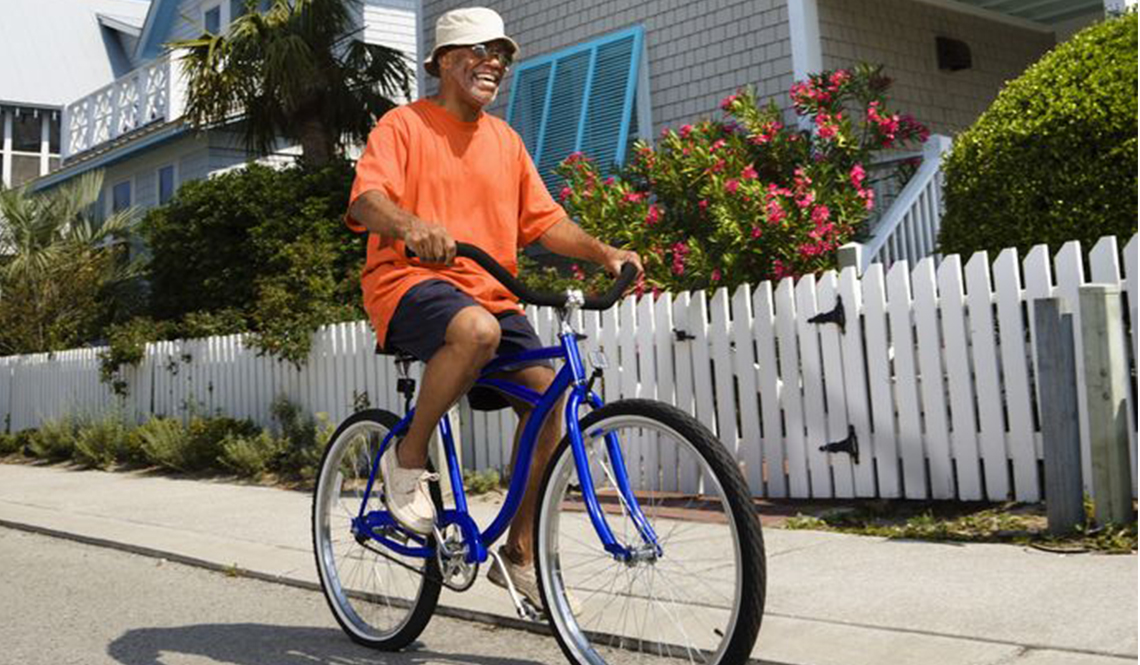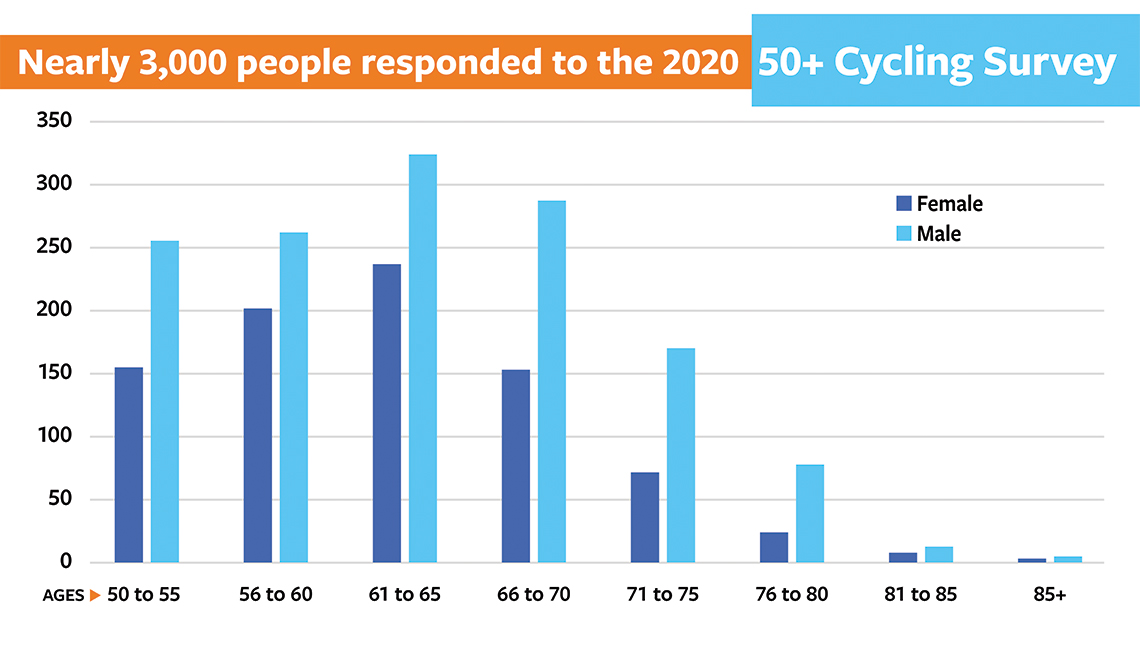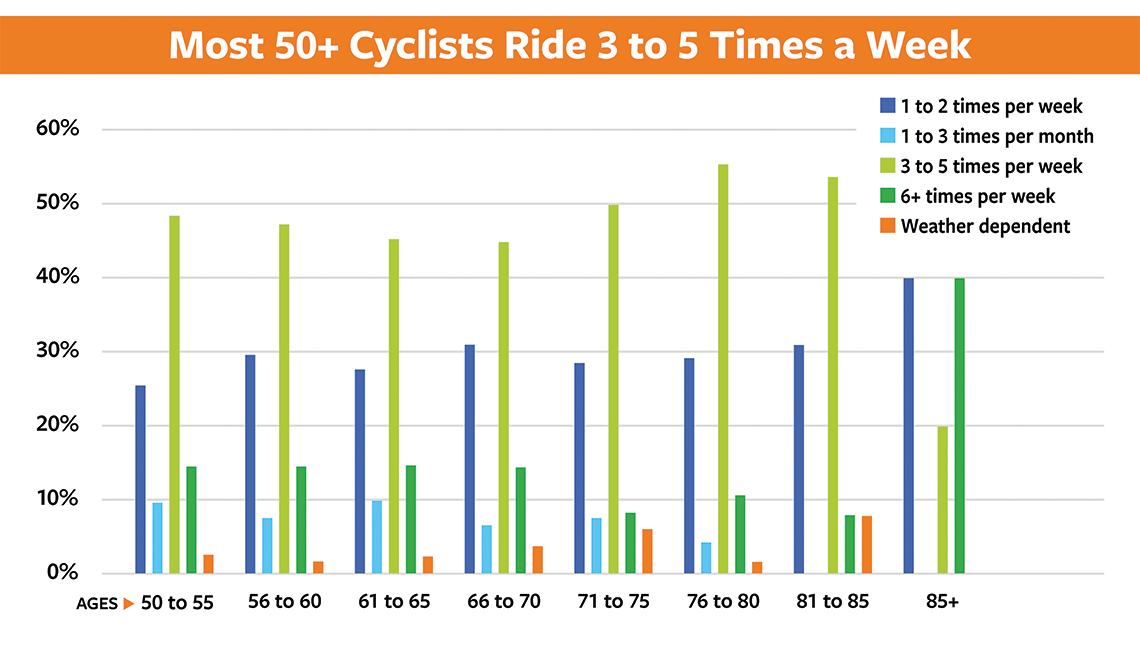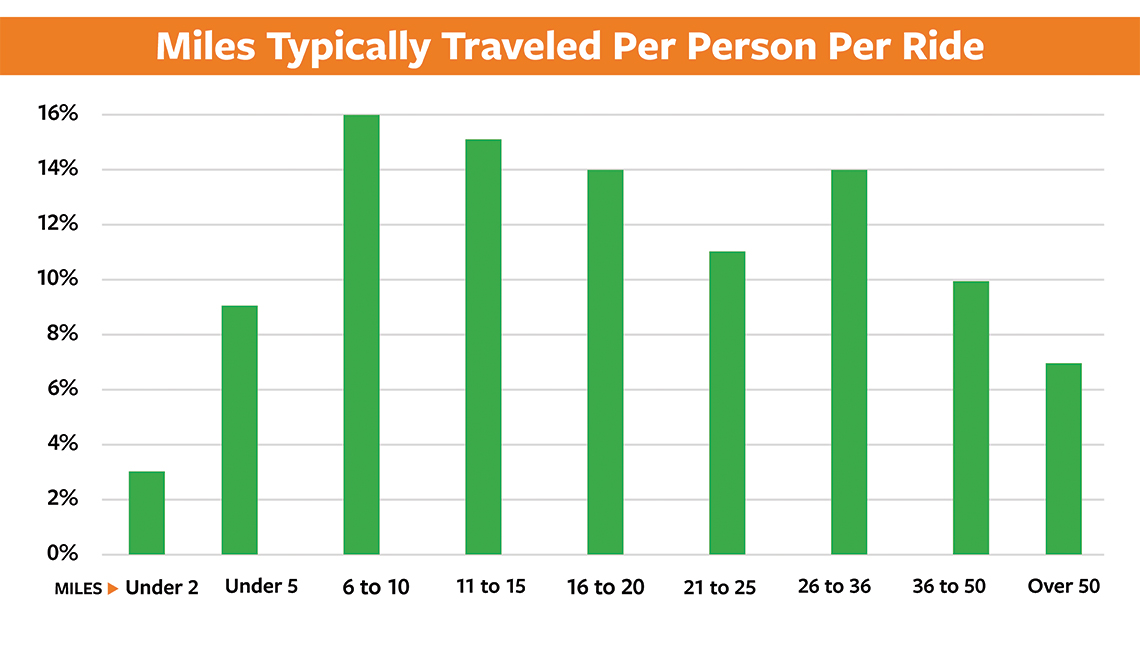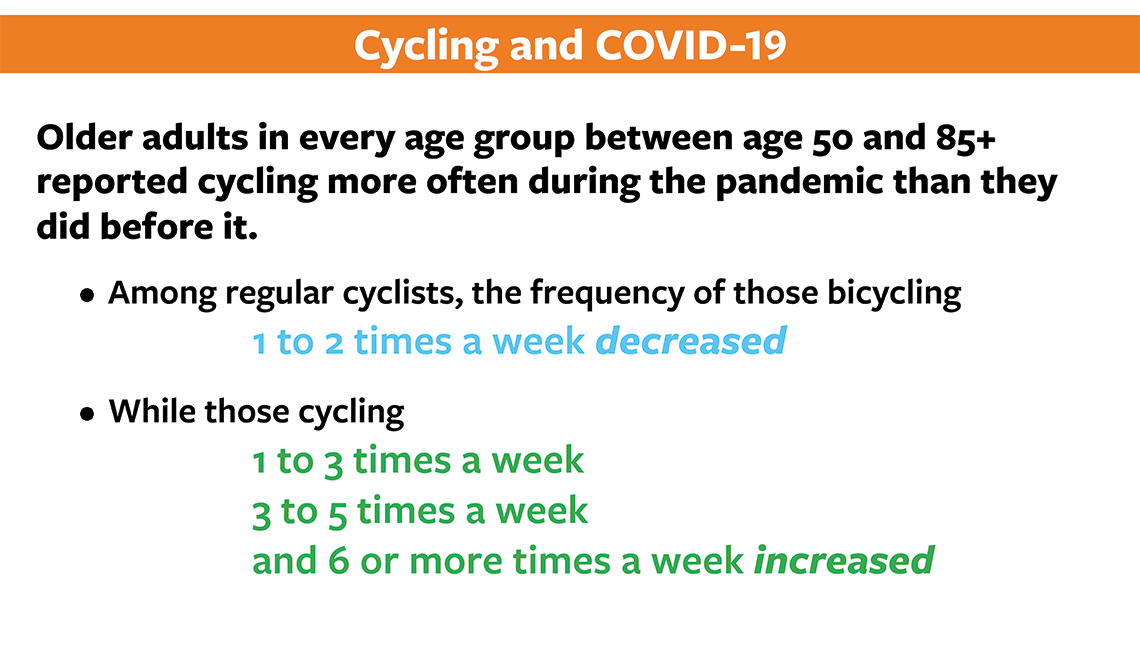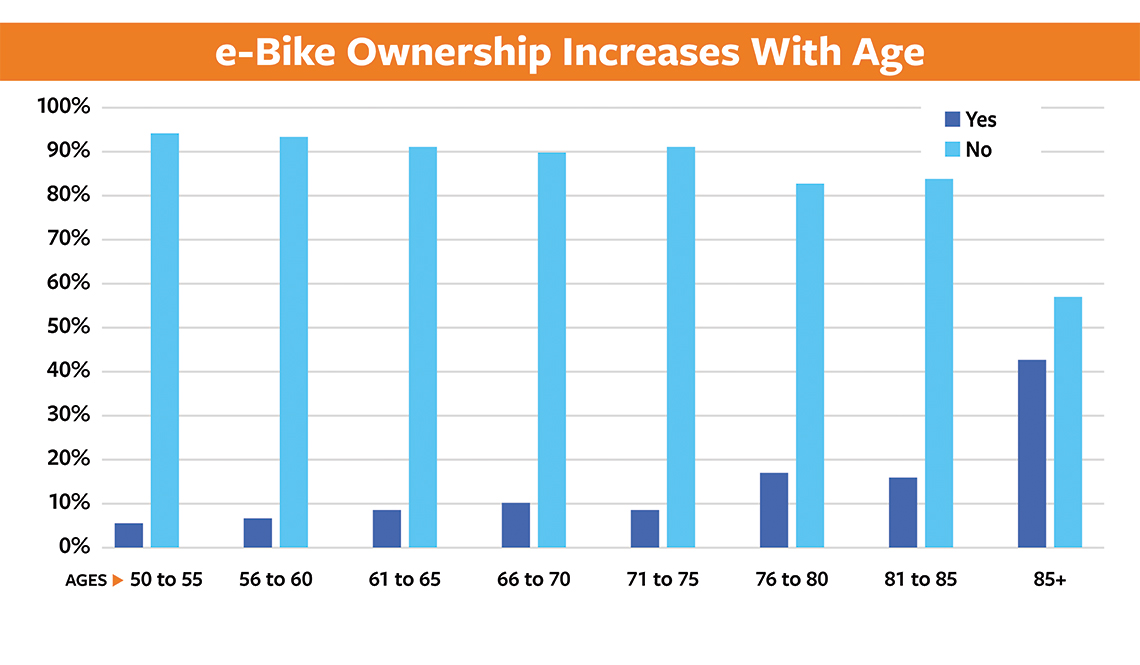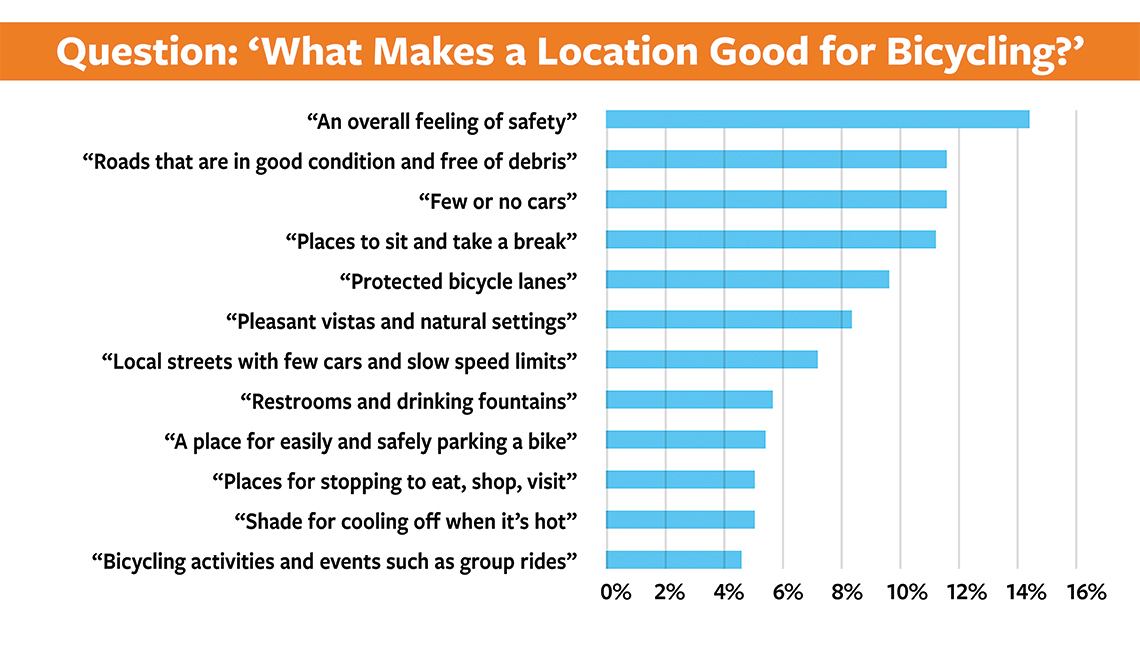The 50+ Cycling Survey
Older cyclists reflect on their bicycling preferences and experiences in a nationwide survey. Many consider cycling to be a staple of their lives and can't envision ever not being able to ride a bike
On a recent summer day, Hannah R., a resident of a small community in upstate Wisconsin, rode the 20 miles of her regular bicycling route, which included a stop at the grocery store on the way home. The septuagenarian is one of the nearly 3,000 older adult cyclists who answered the 2020 edition of the 50+ Cycling Survey.
About the Survey
The 50+ Cycling Survey is a nationwide survey of older bicyclists. Created by Carol Kachadoorian, a transportation planner, older adult mobility specialist and founder of the dblTilde Collaborative, the survey is in its third year. The 2020 questionnaire, which was supported in part by AARP, was completed by almost 3,000 respondents age 50 to 85-plus, near evenly split between women and men, with 12 percent of individuals identifying as non-white. Open for response from February 14 through July 31, 2020, the survey was distributed with the assistance of cycling advocates, planning professionals specializing in active transportation, and through the AARP Livable Communities e-Newsletter and social media platforms.
Respondents answered questions about their cycling history and habits, any changes in their bicycling routine during the past year — including since the COVID-19 pandemic — and their preferences for cycling locations and conditions. Among the key findings:
- Older adults bicycle more often when they have someone to bicycle with.
- COVID-19 has motivated many older adults to start bicycling again or to ride more.
- Older bicyclists want access to a high-quality bike network where “everyday cycling” is supported and there are fewer potential points of conflict with motorists. (Such infrastructure enhancements would include protected bike lanes as well as trails with overpasses and underpasses for safe passage across roadways.)
- Older adults prefer to bicycle in communities that feature easily accessible places to shop, work and socialize.
- Electric assist bicycles — commonly known as e-bikes — are growing in popularity, with use increasing with a rider's age, especially as a way to continue to cycling when stamina declines. (See also "Sales of e-Bikes Heat Up During the Pandemic.")
- Many older adults consider bicycling to be a staple of their lives and cannot envision a time when they would stop riding a bicycle.
See the Stats: The 50+ Cycling Survey
Click the arrows (below left and right) to scroll through all eight slides.
- |
- Photos
Survey by Carol Kachadoorian, dblTilde Collaborative
How Local Leaders Can Support Safe Bicycling
Creating safe streets and sidewalks for all users involves effective community engagement, smart policies and, often, infrastructure changes. Some ways elected officials and other local leaders can advance safe cycling:
Cycling Stories
About 400 people who responded to the 50+ Cycling Survey completed journal entries for two of their rides. The journals captured real-time experiences such as the weather, how the cyclist felt, the trip’s purpose, and information about the trip’s length. Most trips were for recreation — either alone or with others in informal or formal groups — with about the same number of rides for 6 to 10 miles, 11 to 15 miles, 16 to 20 miles, and 26 to 36 miles. The journals also captured information on the safety and comfort of various cycling facilities used. Not surprisingly, cyclists felt the safest and most comfortable in locations with where bicycling paths are separate from motor vehicle traffic.
- Convene community meetings with people who travel by different modes — walking, cycling, driving — to identify needs and concerns, but also to help them learn from one another about their experiences using the street network. The free AARP Roadmap to Livability: Community Listening Session Tool Kit includes step-by-step instructions and worksheets for hosting such discussions and the dblTilde Collaborative offers a suggested meeting agenda.
- Conduct a cycling survey of area residents — including why they bike, what amenities they seek, and what type of infrastructure they favor — and then compare its finding with the community's current bicycle network.
- Demonstrate and/or test cycling infrastructure — such as protected bike lanes — by hosting a pop-up demonstration to show the community what can be done to enhance cycling safety, and then assess the reaction and support for such changes. (The Pop-Up Placemaking Tool Kit, a free publication by AARP and the firm Team Better Block, features information and “recipes” for pop-up bike lanes and other demonstration projects.)
- Develop or update an existing bicycle plan to minimize conflict points between pedestrians, cyclists and drivers. There are many ways to identify locations with conflicts, and there are great resources for learning how to fix them, such as these from the National Association of City Transportation Officials: Urban Bikeway Design Guide, Don’t Give Up the Intersection and the Urban Bikeway Design Guide for All Ages and Abilities.
- Use resources from the League of American Bicyclists, such as its Quick Start Guide to help people bicycle safely, or seek bicycle-friendly certification for your community or business.
- Work with local businesses to establish bike-friendly amenities — such as convenient bike parking — or new services connected to key key locations, on-site parking, etc.
Bicycling at 80+
More than two-dozen people age 80 or older completed the survey. All but two had learned to ride as a child or teenager. Among those who said their cycling habits changed in the past year, they're cycling shorter distances — due to a cycling partner moving away, a health condition or a loss of energy. Those cycling more than in the past report cycling longer distances, often for exercise during the COVID-19 restrictions.
- Establish an effective maintenance program to ensure that cycling surfaces are smooth and free of debris, pavement striping is refreshed regularly, and that signage and protective features are present where needed. See the Federal Highway Administration's Bikeway Selection Guide for ways to incorporate maintenance into facilities planning and operations.
- Support or create bicycling groups and community activities. Sponsor events to support more biking — such as Cicylovia-style "Open Streets" events. Partner with groups (e.g. health, aging and recreation agencies; local bicycle shops; residential communities and facilities for older adults) to identify new opportunities to expland cycling.
- Engage with organizations that pave the way for more inclusive participation, such as those for older people with physical limitations (Cycling Without Age); young riders (the national Youth Bike Summit and Safe Routes to School programs); and women (such as Girls on Bikes and Black Girls Do Bike).
How Individuals Can Support Safe Cycling
- Research the community’s bicycle network to see what exists — and then get out and use the existing network of trails, paths, and separated bike lanes. Check online or pick up a bike map at a local bike shop if you’re unsure of where to begin. Using the existing network is one way to illustrate demand for more and better infrastructure. Pay attention to what is missing — and what future transportation links or amenities may be needed.
- Connect with the community’s bicycle and pedestrian advocacy organizations. Those may be formal advisory commissions or committees, or member-driven bicyling or walking organizations. These groups are critical to advocating for more and better cycling infrastructure. If there’s a vacancy on a commission, consider applying.
- Contact elected officials, the department of transportation or streets, and other people and programs in a position to advance needed change. As a cyclist, you bring valued insight into how the built environment does — or doesn’t — provide a protected, safe and healthy riding experience. Share that insight with local leaders.
Tips for Cycling at 50+
Whether you ride a bike for sport, recreation or as a means of getting around, bicycling is an age-friendly activity that people of all ages can enjoy. Some tips:
- Dust off the bicycle that’s been sitting in storage unused. (Before riding, have the bicycle checked and serviced by a bike shop.)
- If a bicycle is needed, buy a new or re-used one. Make sure it fits properly and has features that promote cycling with ease, whether it's a three-wheeler, e-bike or a traditional two-wheel pedal bike.
- Research local cycling groups and join one. Having others to ride with is a great motivator for starting and continuing riding.
- Invite a friend to ride and explore new places together.
- Make a plan to bicycle regularly, perhaps replacing one car trip with a bike trip.
Not a Bike Rider? Take lessons! It’s rarely too late to learn to ride a bike. Local recreation departments, senior centers and bicycle shops often offer classes. Self-service videos (such as "How to Teach an Adult to Ride a Bike") are available online. Many communities offer classes by League of American Cyclists-certified instructors who can ensure that new riders can take to the road safely and with confidence.
Stay Informed
The weekly, award-winning AARP Livable Communities e-Newsletter provides local leaders with information and inspiration for making their town, city or neighborhood more livable for older adults and people of all ages. Subscribe today!
AARP.org/Livable
Enter a topic, name, place, etc.

